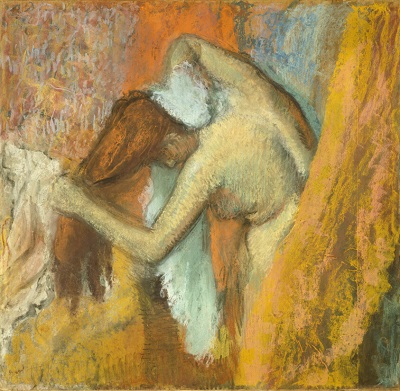
from Amazon
* As an Amazon Associate, and partner with Google Adsense and Ezoic, I earn from qualifying purchases.
Edgar Degas continues to showcase the sensual female body in its nude form. The artist adored to create artwork that either illustrated the bodily movement of performers, or the nude female body. This classic pastel piece illustrates the behind the scene glimpse to a woman bathing.
Degas often showcased artwork that illustrates the behind the scene activities that go on prior to a show. This is showcased through the artwork The Actresses Dressing Room, and Ballerinas Adjusting Their Dresses. These artworks give the viewer a small glimpse into the secrets that occur behind the curtain that the audience is not privy to knowing. Degas adored this concept as he often imagined what truly occurs to create a work of art. This motivation also inspired his ample number of nude portraits of women bathing. Degas was immensely consumed with the idea of what woman do behind closed doors when they finally take off their gowns and reveal their flesh. Whether through an erotic desire, or fascination of the nude female body in its natural form, Degas cultivated a vast collection of this type of artwork.
The Toilette incredibly resembles the artist’s other work Woman At Her Toilette. The piece Woman At Her Toilette illustrates a woman bathing in an abstract impressionism feel. Whereas The Toilette has a more classic post-impressionism style. Rather than blurring the details into one another, the artist decided to showcase the female figure bathing in more detail. Based on the similar setting, and attire, it is most likely that the two paintings are of the same woman. The question that is unanswered is whether Degas has based these pieces off of someone he knew, or his own imagination.
The woman within the painting is standing while leaning forwards upon a teal coloured bowl. The woman is completely nude from the waist upwards with a glimpse of her breasts. Upon her hips lays a white chiffon dress that falls towards the floor that covers her backside. As the woman is leaning towards the counter, the viewer is unable to see her face as her light brown hair covers her face. Degas places a light source near the back of the room and illuminates her body. He showcases the exact curves and folds in the woman’s body as he highlights and contrasts the frame. He shades her spinal cord to show the dimension within her back. He also shades her hips and shoulders to contour her body. The artist uses immense precision to illustrate the woman’s body.
It seems as if the counter she Is leaning upon doubles as her vanity. A yellow-orange hairbrush is seen near the right of the counter. As well, an array of different coloured bottles in front of the mirror are present. A teal blue colour outlines the frame of the mirror. The actual mirror itself reflects the rest of the room.
To the right of the artwork, curtains fill the canvas in different shades and textures. A velvet golden green and orange curtain is filled with a flowery pattern. Another curtain right next to it in a dark burgundy brown flows alongside. Finally, the walls are coloured in a simple white hue. Yet, Degas works to give it dimension and shape by using linear brush strokes to elongate the walls. The dress that hugs the woman’s hips is darkened with hues of blue and grey. While the dress was portrayed as white within the other artwork titled Woman At Her Toilette.